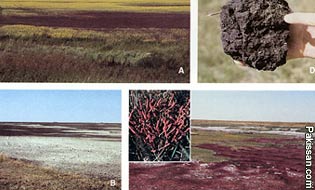|
Saline
agriculture and reclamation approach
Home
By Ghulam Hassan
About 2.67 million hectares in Punjab is under
salinity/sodicity menace at varying degrees. The problem is
on the rise due to prolonged drought and diminishing canal
supplies.
 Fresh
water supplies are decreasing with increasing demand for
drinking, industry and agriculture. Fresh
water supplies are decreasing with increasing demand for
drinking, industry and agriculture.
Under prevailing circumstances it is not advisable to
reclaim sodic or saline sodic soils with gypsum as an acre
foot of quality water is required to leach down the salts
generated by each ton of gypsum. Failing leaching process
such soils will be converted into saline.
Planting of salt tolerant forest or horticultural plants or
salt tolerant crop varieties is known as saline agriculture.
Forest especially Acacia, Prosopis, and Eucalyptus etc., are
highly tolerant to salinity but relatively prone to
sodicity.
Horticultural plants like dates, guava, pomegranate, falsa
etc., also tolerate salinity to varying extent. It is low in
arable crops. Thus, tolerance to salinity by plant is not
absolute but relative. On the other hand in the field,
salinity/sodicity varies to a large extent therefore
establishment of uniform or satisfactory crop stand by usual
farming practices is not obtained and poor harvest or total
failure results.
Soil Salinity Research Institute, Pindi Bhattian has devised
some practices, whereby the success of crops and trees
increases to a great extent in salt affected soils.
It is well documented that successful cultivation of plants
removes salts from the soil and ultimately normal
agriculture is restored on such land. Since the Institute is
located in rice zone, the research was done on rice-wheat
rotation and forest and fruit trees. Soil analysis is a
prerequisite.
In rice cultivation, the steps are enlisted are: raise a
nursery of tolerant species in salt free soil; if the ECe of
the field exceeds 8 dSm-1, flood the field for at least a
week after deep ploughing (if possible) otherwise plough the
field with cultivator; avoid puddling; number of seedlings
per hill should be increased to gypsum requirement plus two;
follow the usual irrigation, fertilizer and plat protection
measures. Returning of rice straw to soil will hasten the
reclamation process.
Germination of wheat seed if sown at field capacity is
reduced if ECe of field exceeds eight, however, tolerant
varieties can sustain somewhat higher salinity. In soils
having ECe more than 10 dSm-1, the sowing method will be to
prepare the field by cultivation and planking; flood the
field and broadcast seed or broadcast seed and flood the
field; or drill the seed and irrigate the field; good crop
stand can be established in saline sodic soil provided its
gypsum requirement is below three tons per acre; But the
first irrigation should be delayed to 35 days and it should
be light; if gypsum requirement of a saline sodic field is
up to five tons per acre, ridge sowing is better; on well
prepared dry land broadcast seed and fertilizer (phosphorus
source should be SSP) and make ridges with ridger and then
irrigate so that crowns are not submerged. It should fill
the furrows between ridges.
Tree plantation: Ultra salt affected soils can be used for
growing of forest or fruit trees like date palm, guava, ber,
jamin etc. If ECe is >30 dSm-1 Acacia Spp. should be
preferred; keeping in view the recommended row to row
distance, make ditches at least one foot deep; dig pits
three feet in diameter and three feet deep at recommended
plant to plant distance; if compact layer is encountered at
this depth, make further three feet deep auger hole in
centre of the pit which will facilitate root penetration up
to six feet; fill the pits with silt and irrigation to
settle the silt; transplant tree sapling in centre of the
pit.
The advantages of it are that it will save precious input
i.e., water and the cost of amendments and their
application; ensure income to the owners of salt affected
lands; facilitate salt transportation rather than their
cycling in the profile; improve the economy of the country.
Courtesy: The DAWN
|
Pakissan.com;
|